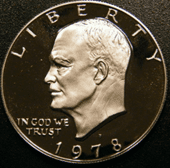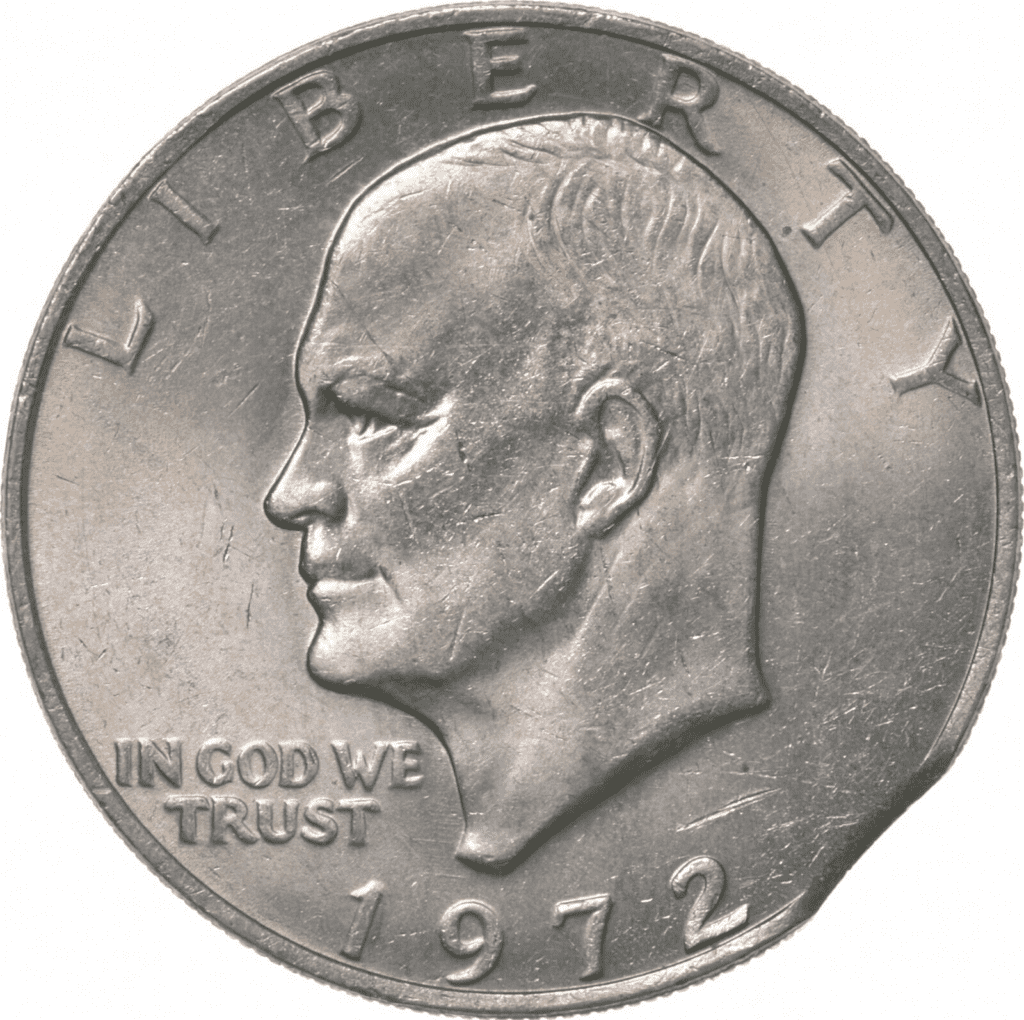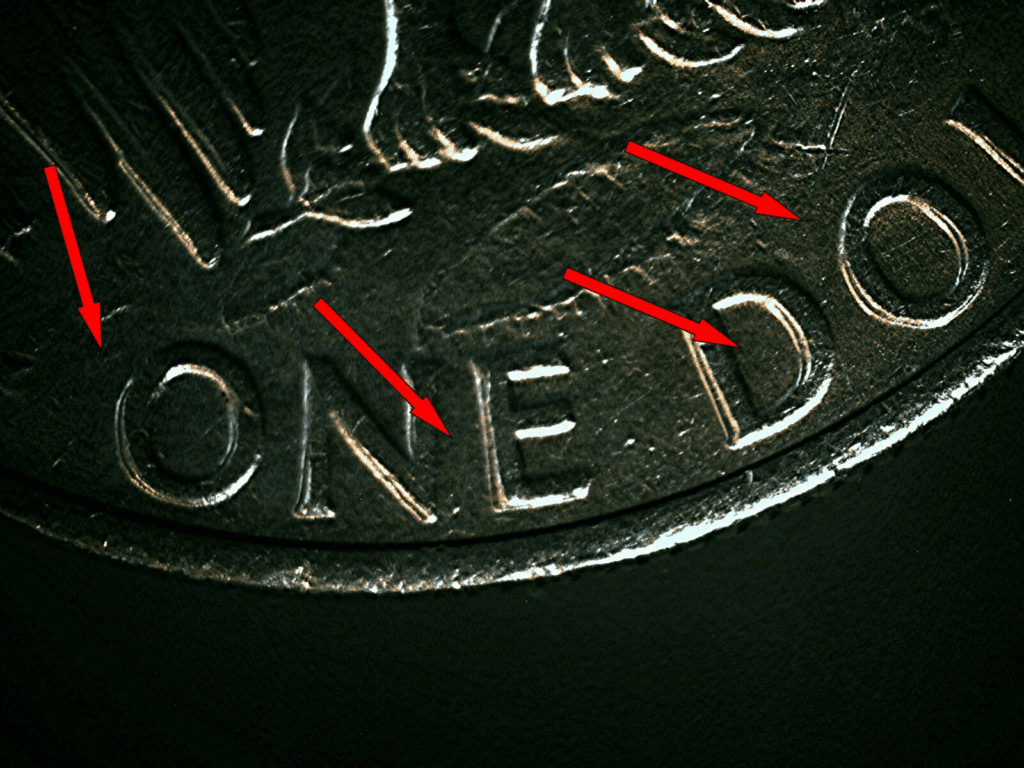What Is the 1978 Eisenhower Dollar Made Of?
The 1978 Eisenhower dollar is primarily made of 75% copper and 25% nickel with its core made of pure copper but it is covered with a mixture of copper and nickel. There is also a different variety of the dollar coin, which was made of 40% silver. The coins made in base metals were produced for circulation while the silver dollar coins were produced for collectors and coin enthusiasts.

photo source: USA Coin Book
The first Eisenhower dollar was struck in 1971. However, it only lasted until 1978. Thus, the 1978 Eisenhower dollar is the final series of its kind.
In 1971, Frank Gasparro designed the Eisenhower dollar. As its name implies, it bears the left-facing, side view of Eisenhower, which is the 34th president of the United States.
Aside from the image of Eisenhower, on the obverse, you will find the following inscriptions:
- LIBERTY
- IN GOD WE TRUST
- 1978
- Mint mark (if present)
On the reverse, you will find the eagle clutching an olive branch, which represents peace. The eagle on the coin is the bald eagle, which is considered by the US a symbol of democracy and freedom.
The eagle is seen to be landing on the surface of the moon. The image of the moon is based on the insignia used by the Apollo 11 mission. The moon landing in 1969 was so important that it was included in the coin’s design.
Aside from the eagle, there’s also an image of the earth found on top of the left wing of the eagle. You’ll also find thirteen stars surrounding the bird.
Aside from the image, you’ll find the following inscriptions:
- UNITED STATES OF AMERICA
- E PLURIBUS UNUM
- ONE DOLLAR
- FG (Frank Gasparro’s initials)
The silver and copper-nickel dollar was never a popular coin. In fact, there was no real need for a dollar coin in 1970. That’s why most dollar coins were sitting in bank vaults rather than in circulation.
The dollar coin was only made as a way to help the gaming industry thrive. In the 1970s, the gaming industry needed a replacement for the silver dollars to feed their slot machines. Congress needed to find a solution. The passing away of Dwight Eisenhower in 1969 gave Congress the idea of creating a coin in honor of this popular war hero.
1978 Eisenhower Dollar Rarities And Varieties
The 1978 Eisenhower dollar comes with various types and rarities. The usual types are differentiated by their mint mark while rarities happen usually due to errors. To learn more about the different 1978 Eisenhower dollar varieties, here’s a list of them:
1978 P Dollar (No Mint Mark)
Edge: Reeded
Mint Mark: No mint mark
Place of minting: Philadelphia
Year of minting: 1978
Face Value: $1 (one dollar)
Quantity produced: 47,799,000
Composition: 75% copper and 25% nickel
Mass: 22.68 grams
Diameter: 38.1 mm
Thickness: 2.58 mm

photo source: Coin Week
1978 – D Dollar
Edge: Reeded
Mint Mark: D
Place of minting: Denver
Year of minting: 1978
Face Value: $1 (one dollar)
Quantity produced: 68,587,424
Composition: 75% copper and 25% nickel
Mass: 22.68 grams
Diameter: 38.1 mm
Thickness: 2.58 mm

photo source: NGC
1978 – S Dollar
For the 1978 S dollar, there are a few varieties you should know. The mint mark “S” refers to San Francisco. The San Francisco Mint produced clad-proof versions of the 1978 dollar coin. Because of a newly introduced process of minting, the resulting coin looks more beautiful because of its increased quality of cameo contrast.
To give you an idea, here are some of the types of 1978 S dollar:
Clad Proof Proof

photo source: eBay
Clad Pr Deep Cam Proof

photo source: eBay
List of errors
With millions of 1979 dollar coins produced, it is not surprising to see some of them have errors. These errors make the coin unique and even rare. Such occurrences cause some coins to have a higher value.
Some errors happened due to various reasons, which may include the following:
- Double strike
- Broad strike
- Broken die
- Off-center strike
- Blank planchet
To give you an example, here’s a coin with clipped error:

photo source: eBay
Here’s an example of a 1978 one-dollar coin with the double strike error:

photo source: eBay
How Much Is A 1978 Eisenhower Dollar Worth Today?
Do you have a 1978 Eisenhower dollar? Or, are you planning to buy one? Whether you want to sell or buy a 1978-dollar coin, one thing that you want to know is the price.
To give you an idea, here’s a table of prices:
| Coin | Condition | Grade | Price |
| Standard 1978 Eisenhower Dollar coin | Circulated | Not graded | $1.00 |
| 1978 Eisenhower Dollar coin | Uncirculated | MS 65 | $18 |
| 1978 Eisenhower Dollar coin | Uncirculated | MS 66 | $72 |
| 1978 Eisenhower Dollar coin | Uncirculated | MS 67 | $5,000 (approximate) |
Price guides are just indicative. 1978 coins with pristine conditions can be sold for several thousand dollars, especially in the open market. The rare and unique coins are even more expensive compared to standard dollar-coin varieties.
How Does The Grading System Work?
The Sheldon Scale is used by numismatists to provide a numerical value to coins. The Sheldon Scale goes from poor (P-1) to perfect mint state (P-1) (MS-70). Coins were originally evaluated using words to reflect their condition (Good, Fair, Excellent, Etc.). Unfortunately, coin collectors and dealers had different ideas about what each of these terms represent.
Professional numismatists joined together in the 1970s and established CoinGrading standards. These numismatists now assign grades at key places on the seventy-point scale, using the most regularly utilized numeric points in conjunction with the original adjective grade. The following are the most common coin grades:
-
-
- (P-1) Poor – Indistinguishable and probably damaged; if used, must have a date and mintmark; otherwise, rather battered.
- (FR-2) Fair – Nearly smooth, but without the damage that a coin graded Poor often possesses. The coin must have enough detail to be identified.
- (G-4) Fair – Inscriptions have merged into the rims in some areas, and important elements have been mostly erased.
- (VG-8) Very Good- A little weathered, but all of the primary design elements are visible, albeit faintly. There is little if any, central detail left.
- (F-12) Good – The item is very worn, yet the wear is even, and the overall design details stand out clearly. Rims are almost completely isolated from the field.
- (VF-20) Very Fine – Moderately weathered, with some finer features still visible. The motto or all letters of LIBERTY are readable. Both sides of the coin have entire rims that are separated from the field.
- (EF-40) Extremely Fine – Gently used; all gadgets are visible, and the most important ones are bold. The finer details are bold and clear, however, light wear may be seen.
- (AU-50) Uncirculated – Slight evidence of wear on the coin’s design’s high points; may have contact marks; eye appeal should be adequate.
- (AU-58) Uncirculated Choice – Slight traces of wear, no severe contact marks, almost full mint shine, and great eye appeal.
- (MS-60) Mint State Basal – Strictly uncirculated; no indication of wear on the coin’s highest points, but an unsightly coin with reduced luster, visible contact marks, hairlines, and other flaws.
- (MS-63) Mint State Acceptable – Uncirculated, but with contact scratches and nicks, little reduced shine, but otherwise appealing appearance. The strike is weak to average.
- (MS-65) Mint State Choice – Uncirculated with great mint shine, very little contact blemishes, and exceptional eye appeal. The strike is unusually severe.
- (MS-68) Mint State Premium Quality – Uncirculated with superb luster, no obvious contact marks to the naked eye, and exceptional eye appeal. The strike is quick and appealing.
- (MS-69) Almost Perfect Mint State – Uncirculated with perfect brilliance, a sharp and appealing strike, and extremely good eye appeal. A near-perfect coin with minor imperfections in the planchet, strike, and contact markings (seen only under 8x magnification).
- (MS-70) Mint State Perfect – Under 8x magnification, there are no tiny imperfections discernible; the strike is crisp, and the coin is perfectly centered on a beautiful planchet. Rarely seen on a coin, this coin is bright and whole, with original luster and exceptional eye appeal.
-
Where To Buy 1978 Eisenhower Dollar?
The 1978 Eisenhower dollar coin is available in certain coin shops, antique shops, and private sellers.
Today, the fastest way for you to find a 1978 Eisenhower dollar would be online. All you need is to do a quick Google search, type in “1978 Eisenhower dollar for sale,” and press enter. You would then be given a list of websites where you can buy the dollar coin.
Some of the most common websites where you can buy the 1978 Eisenhower dollar coin would be eBay and Amazon. Aside from that, there are websites that specialize in selling and buying coins.
Now, you might ask, “What should I look for in an Eisenhower dollar?”
The first thing you should do is get familiar with ordinary 1978 Eisenhower coins. These coins don’t sell much and would just be sold by their face value.
Once you know what an ordinary Eisenhower dollar looks like, you will have a better way of identifying coins with special features and unique appearances.
The first thing you need to check is of course the date. It should be 1978 since that’s the series you’re looking for.
If you’re after silver dollar coins, you need to remember that they can be difficult to find in circulation.
For one, the US Mint produced silver 1978 Eisenhower dollar coins and sold them to collectors.
If you want to know if your Eisenhower dollar coin is made of silver, you can look at the edge. If it is made of solid silver color, then that’s an indication that you have silver.
Aside from that, try to drop your coin. If it is silver, you’ll hear a higher-pitched sound. Compare that to copper-nickel dollar coins that would have a dull thud upon hitting the floor. Get an ordinary dollar coin and do a drop test with the coin you suspect to be silver. You can then simply compare their sound.
Aside from that, try to weigh your coin. Coins with base metal are lighter compared to silver coins.
There are also other rare 1978-dollar coins you should know about. Check for any unique errors, which can make your coin rare.
Look at the overall appearance of your coin as well. Coins with more pronounced details and great eye appeal come with a higher price.
If you are not sure, find coins that are already graded. These coins went through a rigorous assessment and so, you can be more confident that the coin you’re looking at is legitimately valuable.
FAQs
Who is on the 1978 dollar coin?
The 1978 dollar coin has Dwight Eisenhower’s bust. Eisenhower was the 34th president of the United States and at the same time, a well-respected hero of World War II. As a way to honor his contribution to the US, the dollar coin was dedicated to him.
How to know if a 1978 Eisenhower dollar is silver?
To know if you have a silver 1978 Eisenhower dollar, you can do a drop test. Silver will have a higher pitch when it hits the ground. Moreover, silver is heavier than an ordinary dollar coin.
Look at the reed as well. If it has a solid silver stripe, it can be made of silver. Get in touch with a qualified coin grader to confirm if you have a silver dollar or not.
What makes a 1978 Eisenhower dollar rare?
A 1978 Eisenhower dollar is rare when it has unique characteristics and attributes. For example, a coin that incurs an error during the minting process can be considered rare.
Where is the mint mark of a 1978 Eisenhower dollar coin?
The mint mark of a 1978 Eisenhower dollar coin is found just below the bust of Eisenhower. Mint marks can be D for Denver and S for San Francisco. Dollar coins issued in Philadelphia don’t have any mint marks.







